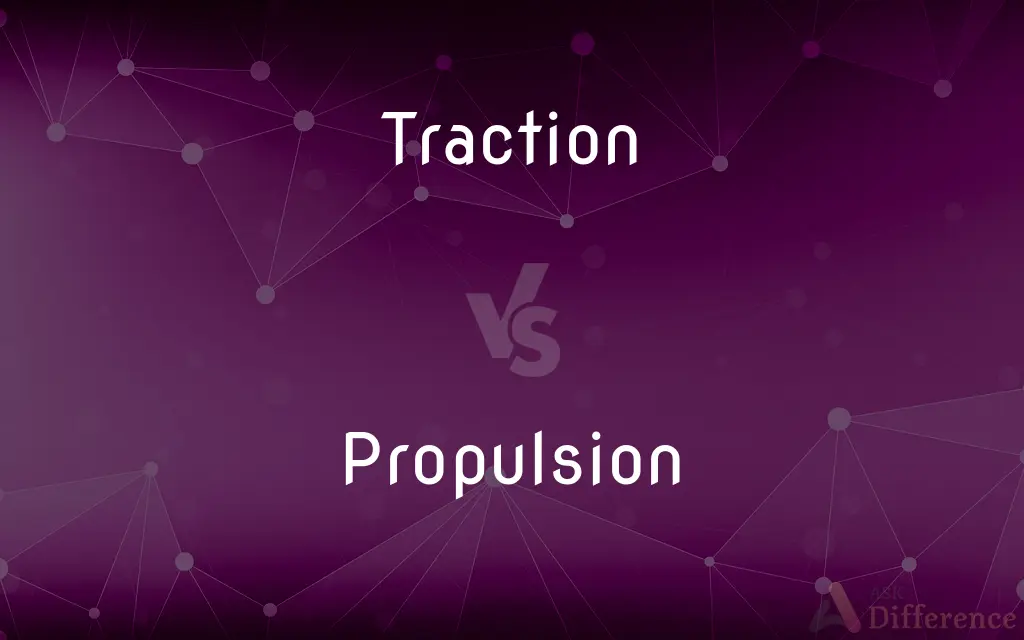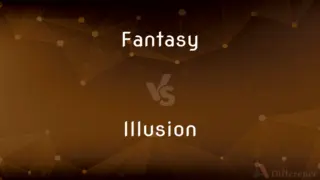Traction vs. Propulsion — What's the Difference?
By Tayyaba Rehman & Urooj Arif — Updated on April 29, 2024
Traction refers to the force that allows an object to move across a surface without slipping, while propulsion is the force that drives an object forward or propels it through a medium like air or water.

Difference Between Traction and Propulsion
Table of Contents
ADVERTISEMENT
Key Differences
Traction is essentially the frictional force between a surface and the wheels or feet of a vehicle or creature, enabling movement without slippage. This is crucial for effective motion on ground surfaces, ensuring stability and control. On the other hand, propulsion refers to any mechanism that pushes or moves an object in a desired direction, typically involving engines or motors in vehicles, which can include mechanisms like propellers, jet engines, or even muscular action in animals.
The role of traction is integral in preventing vehicles from skidding on roads, particularly under conditions like ice or rain. It is a key factor in the design of tires and the development of road surfaces to maximize grip. Whereas propulsion systems are designed based on the environment in which they operate, such as propellers for boats in water or jet engines for aircraft in air, focusing on maximizing efficiency and speed.
Traction is typically associated with the contact surface and the materials involved, such as rubber tires on asphalt roads or metal tracks on railroads. The effectiveness of traction depends significantly on these material properties and the environmental conditions. In contrast, propulsion systems often involve energy conversion, such as burning fuel to create thrust in jet engines or converting electrical energy into mechanical motion in electric motors.
In terms of technology, improvements in traction have led to the development of anti-lock braking systems (ABS) and traction control systems in vehicles, which help maintain control during acceleration and deceleration. Meanwhile, advancements in propulsion technology have led to more efficient and powerful engines, as well as innovations like electric propulsion and hybrid systems that combine different types of propulsion for optimal performance.
Both traction and propulsion are essential for the operation of vehicles but serve different functions. Traction is about maintaining contact and control on the surface, while propulsion is about moving an object from one point to another, overcoming inertia and other resistive forces.
ADVERTISEMENT
Comparison Chart
Definition
The force that prevents slipping on a surface
The force that moves an object forward
Primary Focus
Friction and grip between surfaces
Generating and managing force to move an object
Key Technologies
Anti-lock braking systems, traction control
Engines, motors, propellers
Associated with
Wheels, tires, road surfaces
Engines, fuel, energy sources
Importance
Essential for control and stability
Essential for movement and efficiency
Compare with Definitions
Traction
The grip between a surface and an object allowing movement without slipping.
The car's traction on the icy road was improved with winter tires.
Propulsion
The act or process of driving or pushing forward.
Jet engines are critical for the propulsion of an aircraft.
Traction
Depends on both the material properties and environmental factors.
Wet roads significantly reduce vehicle traction.
Propulsion
Essential in various modes of transport, from automobiles to spacecraft.
Propulsion technology determines the speed and range of vehicles.
Traction
Often relates to tires, footwear, or any contact points with ground or floor.
Athletes require shoes with good traction for better performance.
Propulsion
Involves mechanisms like engines, thrusters, or natural muscle force.
Rockets use controlled explosions for propulsion.
Traction
Enhanced through technological advancements in materials and design.
Modern tires are designed to maximize traction on diverse road conditions.
Propulsion
Focuses on overcoming resistive forces to maintain and increase speed.
Aerodynamic design enhances propulsion efficiency in cars.
Traction
Important for safety and operational efficiency in vehicles.
Traction control systems help prevent accidents in slippery conditions.
Propulsion
Innovations include electric and hybrid propulsion systems.
Hybrid cars use both combustion engines and electric motors for improved propulsion.
Traction
The act of drawing or pulling, especially the drawing of a vehicle or load over a surface by motor power.
Propulsion
Propulsion is the action or process of pushing or pulling to drive an object forward. The term is derived from two Latin words: pro, meaning before or forward; and pellere, meaning to drive.
Traction
The condition of being drawn or pulled.
Propulsion
The process of driving or propelling.
Traction
Pulling power, as of a draft animal or engine.
Propulsion
A driving or propelling force.
Traction
Adhesive friction, as of a wheel on a track or a tire on a road.
Propulsion
The action of driving or pushing, typically forward or onward; a propulsive force or impulse.
Traction
(Medicine) A sustained pull applied mechanically especially to the arm, leg, or neck so as to correct fractured or dislocated bones, overcome muscle spasms, or relieve pressure.
Propulsion
The act driving forward or away; the act or process of propelling; as, steam propulsion.
Traction
(Informal) Impetus or advancement, as toward a desired result
The bill gained traction in the Senate and was passed by a large majority.
Propulsion
An impelling act or movement.
God works in all things; all obeyHis first propulsion.
Traction
The act of pulling something along a surface using motive power.
Propulsion
A propelling force
Traction
The condition of being so pulled.
Propulsion
The act of propelling
Traction
Grip.
Traction
The pulling power of an engine or animal.
Traction
The adhesive friction of a wheel etc on a surface.
Traction
Progress in or momentum toward achieving a goal, especially in gaining support, recognition, or popularity.
Traction
(business) The extent of adoption of a new product or service, typically measured in number of customers or level of revenue achieved.
Traction
(politics) Popular support.
Traction
(academia) Scholarly interest and research.
Traction
(medicine) A mechanically applied sustained pull, especially to a limb.
Traction
(transport) Collectively, the locomotives of a railroad, especially electric locomotives.
Traction
To apply a sustained pull to (a limb, etc.).
Traction
The act of drawing, or the state of being drawn; as, the traction of a muscle.
Traction
Specifically, the act of drawing a body along a plane by motive power, as the drawing of a carriage by men or horses, the towing of a boat by a tug.
Traction
Attraction; a drawing toward.
Traction
The adhesive friction of a wheel on a rail, a rope on a pulley, or the like; as, the car is stuck in the snow because it can;t get any traction.
Traction
The friction between a body and the surface on which it moves (as between an automobile tire and the road)
Traction
(orthopedics) the act of pulling on a bone or limb (as in a fracture) to relieve pressure or align parts in a special way during healing;
His leg was in traction for several days
Common Curiosities
Why is traction important in vehicles?
It ensures stability and control, preventing the vehicle from skidding, especially under adverse conditions.
What is the main difference between traction and propulsion?
Traction is about the grip and friction required to move without slipping, whereas propulsion is about creating force to move forward.
What role does traction play in sports?
Good traction in sports footwear helps athletes maintain balance and perform effectively without slipping.
What are some examples of propulsion systems?
Engines in cars, propellers in boats, and jet engines in aircraft are all examples of propulsion systems.
How do traction and propulsion work together in a vehicle?
Traction maintains grip on the road, allowing the propulsion system's force to effectively move the vehicle.
Can propulsion occur without traction?
In some contexts, like spacecraft in space, propulsion can occur without traditional traction since there's no contact surface.
Are there any environmental impacts associated with propulsion?
Yes, especially from combustion engines which can emit pollutants unless managed with clean technology.
How does weather affect traction?
Adverse weather conditions like rain or snow can reduce traction, making it harder to control movement.
What innovations have been made in propulsion technologies?
Advances include more efficient fuel usage, electric engines, and hybrid systems combining different propulsion types.
What future developments are expected in traction technology?
Future developments may include smarter materials and systems that adapt traction dynamically to different conditions.
Share Your Discovery

Previous Comparison
Drama vs. Tragedy
Next Comparison
Fantasy vs. IllusionAuthor Spotlight
Written by
Tayyaba RehmanTayyaba Rehman is a distinguished writer, currently serving as a primary contributor to askdifference.com. As a researcher in semantics and etymology, Tayyaba's passion for the complexity of languages and their distinctions has found a perfect home on the platform. Tayyaba delves into the intricacies of language, distinguishing between commonly confused words and phrases, thereby providing clarity for readers worldwide.
Co-written by
Urooj ArifUrooj is a skilled content writer at Ask Difference, known for her exceptional ability to simplify complex topics into engaging and informative content. With a passion for research and a flair for clear, concise writing, she consistently delivers articles that resonate with our diverse audience.
















































